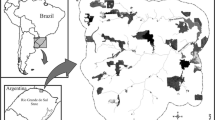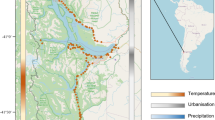Abstract
Habitat patch colonization dynamics and distribution patterns were analysed at a landscape scale in four invasive Fallopia (Polygonaceae) species. Fallopia sachalinensis and F. aubertii were uncommon and population expansion was not evident during the three consecutive years of study. The two most widespread species, F. japonica and F. × bohemica displayed similar habitat selection patterns with ruderal and natural/semi-natural forests favoured. The highest densities of F. japonica and F. × bohemica individuals were at the edge of preferred habitat patches with different patterns of edge selection. Linear network played an important role in species invasion, with 71% of all F. japonica and F. × bohemica occurring within a 10 m buffer of total linear networks (roads, railways, and rivers). However, the buffer represented only 14.5% of the total landscape surface. The rate of population increase was higher for F. japonica (75.8% and 35.2%, in 2002 and 2003, respectively) than for F. × bohemica (63.6% and 0% in 2002 and 2003, respectively) and was largely the result of intra-patch dynamics with low inter-patch colonization. The total surface area occupied by Fallopia clones in the landscape grew by 34.7% over 2 years of the study, with comparable area growth means for F. japonica and F. × bohemica (34.9% and 34.7%, respectively). The hypothesis that F. × bohemica exhibits higher invasive dynamics due to both clonal and sexual reproduction was not supported by our results.


Similar content being viewed by others
References
Adriaens T, Gomez GMS, Maes D (2008) Invasion history, habitat preferences and phenology of the invasive ladybird Harmonia axyridis in Belgium. Biocontrol 53:69–88. doi:10.1007/s10526-007-9137-6
Bailey JP (2003) New records for Fallopia × conollyana: is it truly such a rarity? Watsonia 24:451–453
Bailey JP, Stace CA (1992) Chromosome number, morphology, pairing, and DNA values of species and hybrids in the genus Fallopia (Polygonaceae). Plant Syst Evol 180:29–52. doi:10.1007/BF00940396
Bailey JP, Wisskirchen R (2006) The distribution and origins of Fallopia × bohemica (Polygonaceae) in Europe. Nord J Bot 24:173–199
Bailey JP, Child L, Conolly AP (1996) A survey of the distribution of Fallopia × Bohemica (Chrtek & Chrtkova) J. Bailey (Polygonaceae) in the British Isles. Watsonia 21:187–198
Beerling DJ (1991) The effect of riparian land use on the occurrence and abundance of Japanese knotweed Reynoutria japonica on selected rivers in South Wales. Biol Conserv 55:329–337. doi:10.1016/0006-3207(91)90036-9
Beerling DJ, Bailey JP, Conolly AP (1994) Biological flora of the British Isles. Fallopia japonica (Houtt.) Ronse Decraene. J Ecol 82:959–979. doi:10.2307/2261459
Bímová KBE, Mandák BBC, Pyšek P (2003) Experimental study of vegetative regeneration in four invasive Reynoutria taxa (Polygonaceae). Plant Ecol 166:1–11. doi:10.1023/A:1023299101998
Bímová K, Mandák B, Kašparová I (2004) How does Reynoutria invasion fit the various theories of invasibility. J Veg Sci 15:495–504. doi:10.1658/1100-9233(2004)015[0495:HDRIFT]2.0.CO;2
Boyer M (2002) Cartographie des renouées du Japon sur le réseau hydrographique du bassin Rhone-Méditerranée-Corse (Hors Saone-Doubs). In: Journées techniques nationales “renouées”. Association Echel, Besançon, France
Buse A (1988) Habitat selection and grouping of beetles (Coleoptera). Holarctic Ecol 11:241–247
Child L, de Waal L (1997) The use of GIS in the management of Fallopia japonica in the urban environment. In: Brock JH, Wade M, Pyšek P, Greene DF (eds) Plant invasions: studies from North America and Europe. Backhuys Publishers, Leiden, The Netherlands, pp 207–220
Child L, Wade M (2000) The Japanese knotweed manual. Packard Publishing Limited, Chichester, West Sussex
Christen D, Matlack G (2006) The role of roadsides in plant invasions: a demographic approach. Conserv Biol 20:385–391. doi:10.1111/j.1523-1739.2006.00315.x
Cock MJW (1978) The assessment of preference. J Anim Ecol 47:805–816. doi:10.2307/3672
Collingham YC, Wadsworth RA, Huntley B, Hulme PE (2000) Predicting the spatial distribution of non-indigenous riparian weeds: issues of spatial scale and extent. J Appl Ecol 37(Suppl 1):13–27. doi:10.1046/j.1365-2664.2000.00556.x
Conolly AP (1977) The distribution and history in the British Isles of some alien species of Polygonum and Reynoutria. Watsonia 11:291–311
Duriez O, Ferrand Y, Binet F, Corda E, Gossmann F, Fritz H (2005) Habitat selection of the Eurasian woodcock in winter in relation to earthworms availability. Biol Conserv 122:479–490. doi:10.1016/j.biocon.2004.08.011
Forman RTT, Alexander LE (1998) Roads and their major ecological effects. Annu Rev Ecol Syst 29:207–231. doi:10.1146/annurev.ecolsys.29.1.207
Fox MD, Fox BJ (1986) The susceptibility of natural communities to invasion. In: Groves RH, Burdon JJ (eds) Ecology of biological invasions. Cambridge University Press, New York, pp 57–66
Gammon MA, Grimsby JL, Tsirelson D, Kesseli RV (2007) Molecular and morphological evidence reveals introgression in swarms of the invasive taxa Fallopia japonica, F. sachalinensis, and F. × bohemica (Polygonaceae) in the United States. Am J Bot 94:948–956. doi:10.3732/ajb.94.6.948
Godefroid S (1996) A propos de l’extension spectaculaire de Fallopia japonica, F. sachalinensis, Buddleja davidii et Senecio inaequidens en région bruxelloise. Dumotiera 63:9–16
Grimsby JL, Tsirelson D, Gammon MA, Kesseli RV (2007) Genetic diversity and clonal vs. sexual reproduction in Fallopia spp. (Polygonaceae). Am J Bot 94:957–964. doi:10.3732/ajb.94.6.957
Hathaway S (2000) Surveys on the spread of Japanese knotweed Fallopia japonica in Swansea and strategies for its control. Asp Appl Biol 28:55–62
Hobbs RJ, Humphries SE (1995) An integrated approach to the ecology and management of plant invasions. Conserv Biol 9:761–770. doi:10.1046/j.1523-1739.1995.09040761.x
Huang H, Zhang L (2007) A study of the population dynamics of Spartina alterniflora at Jiuduansha shoals, Shanghai, China. Ecol Eng 29:164–172. doi:10.1016/j.ecoleng.2006.06.005
Jager C (1994) Repartition, écologie et possibilités de contrôle de l’expansion de la renouée du Japon en Lorraine. Mémoire de Maîtrise. Université de Metz, Metz
Jalas J, Suominen J (1979) Atlas florae europaeae. 4. Polygonaceae. Societas Vanamo, Helsinki, Finland
Kamler JF, Gipson PS (2000) Space and habitat use by resident and transient coyotes. Can J Zool 78:2106–2111. doi:10.1139/cjz-78-12-2106
Lonsdale WM (1999) Global patterns of plant invasions and the concept of invasibility. Ecology 80:1522–1536
Mandák BBC, Pyšek P, Bímová KBE (2004) History of the invasion and distribution of Reynoutria taxa in the Czech Republic: a hybrid spreading faster than its parents. Preslia, Praha 76:15–64
Manly BFJ, McDonald LL, Thomas DL (1993) Resource selection by animals: statistical design and analysis for field studies. Chapman and Hall, London
Martinez J-J, Wool D (2006) Sampling bias in roadsides: the case of galling aphids in Pistacia trees. Biodivers Conserv 15:2109–2121. doi:10.1007/s10531-004-6685-2
Marvier M, Kareiva P, Neubert MG (2004) Habitat destruction, fragmentation, and disturbance promote invasion by habitat generalists in a multispecies metapopulation. Risk Anal 24:869–878. doi:10.1111/j.0272-4332.2004.00485.x
Panetta FD, Hopkins AJ (1991) Weeds in corridors: invasion and management. In: Saunders DA, Hobbs RJ (eds) Nature conservation 2: the role of corridors. Surrey Beatty and Sons, London, pp 341–351
Parendes LA, Jones JA (2000) Role of light availability and dispersal in exotic plant invasion along roads and streams in the H. J. Andrews experimental forest, Oregon. Conserv Biol 14:64–75. doi:10.1046/j.1523-1739.2000.99089.x
Pashley CH, Bailey JP, Ferris C (2007) Clonal diversity in British populations of the alien invasive giant knotweed, Fallopia sachalinensis (F. Schmidt) Ronse Decraene, in the context of European and Japanese plants. Watsonia 26:359–371
Perrins J, Fitter A, Williamson M (1993) Population biology and rates of invasion of three introduced Impatiens species in the British Isles. J Biogeogr 20:33–44. doi:10.2307/2845737
Pyšek P, Prach K (1993) Plant invasions and the role of riparian habitats: a comparison of four species alien to central Europe. J Biogeogr 20:413–420. doi:10.2307/2845589
Pyšek P, Richardson DM (2006) The biogeography of naturalization in alien plants. J Biogeogr 33:2040–2050. doi:10.1111/j.1365-2699.2006.01578.x
Pyšek P, Mandák B, Francirkova T, Prach K (2001) Persistence of stout clonal herbs as invaders in the landscape: a field test of historical records. In: Brundu G, Brock J, Camarda I, Child L, Wade M (eds) Plant invasions: species ecology and ecosystem management. Backhuys, Leiden, Netherlands, pp 235–244
Pyšek P, Brock JH, Bímová K, Mandák B, Jarosík V, Koukolíková I, Pergl J, Stepánek J (2003) Vegetative regeneration in invasive Reynoutria (Polygonaceae) taxa: the determinant of invasibility at the genotype level. Am J Bot 90:1487–1495
Richardson DM, Holmes PM, Esler KJ, Galatowitsch SM, Stromberg JC, Kirkman SP, Pyšek P, Hobbs RJ (2007) Riparian vegetation: degradation, alien plant invasions, and restoration prospects. Divers Distrib 13:126–139
Saintenoy-Simon J (2003) Les plantes exotiques naturalisées et les espèces invasives de Wallonie. Parcs et Réserves 58:23–39
Song IJ, Hong SK, Kim HO, Byun B, Gin Y (2005) The pattern of landscape patches and invasion of naturalized plants in developed areas of urban Seoul. Landsc Urban Plan 70:205–219. doi:10.1016/j.landurbplan.2003.10.018
Tiébré M-S, Bizoux J-P, Hardy OJ, Bailey JP, Mahy G (2007a) Hybridization and morphogenetic variation in the invasive alien Fallopia (Polygonaceae) complex in Belgium (Western Europe). Am J Bot 94:1900–1910. doi:10.3732/ajb.94.11.1900
Tiébré M-S, Vanderhoeven S, Saad L, Mahy G (2007b) Hybridization and sexual reproduction in the invasive alien Fallopia (Polygonaceae) complex in Belgium. Ann Bot 99:193–203. doi:10.1093/aob/mcl242
Vanden Berghem C (1997) La renouée du Japon en Belgique. Adoxa 15/16:35–38
Verloove F (2002) Ingeburgerde plantensoorten in Vlaanderen, vol 20. Mededeling van het Instituut voor Natuurbehoud, Brussels
Vitousek PM, D’antonio CM, Loope LL, Rejmanek M, Westbrooks R (1997) Introduced species: a significant component of human-caused global change. N Z J Ecol 21:1–16
Voinot JB, Gaillard V, Solviche A (2002) Distribution géographique de la renouée du Japon sur la tête du bassin versant Rhone-Méditerranée-Corse. Elaboration de stratégies de régulation. In: Journées techniques nationales “renouées”. Association Echel, Besançon, France
Wang R, Wang Y (2006) Invasion dynamics and potential spread of the invasive alien plant species Ageratina adenophora (Asteraceae) in China. Divers Distrib 12:397–408. doi:10.1111/j.1366-9516.2006.00250.x
Weber E (2003) Invasive plants in the world: a reference guide to environmental weeds. CABI-Publishing, London, UK
Wilcove DS (1998) Quantifying threats to imperiled species in the United States. Bioscience 48:607–615. doi:10.2307/1313420
Zimmer MP, Power M (2006) Brown trout spawning habitat selection preferences and redd characteristics in the Credit River, Ontario. J Fish Biol 68:1333–1346. doi:10.1111/j.0022-1112.2006.00995.x
Acknowledgements
We thank Béatrice Lagrange for field assistance, John P. Bailey for improving our English and an anonymous reviewer for helpful suggestions. Marie-S. Tiébré was funded by the Ministry of Education and Scientific Research of the Republic of Ivory Coast. This research was supported by the Belgian Science Policy project “INPLANBEL: Invasive Plants in Belgium: Patterns, Processes and Monitoring” (contract EV/11/27C) and by the F.R.S.-FNRS (contract FRFC 2.4556.05).
Author information
Authors and Affiliations
Corresponding author
Rights and permissions
About this article
Cite this article
Tiébré, MS., Saad, L. & Mahy, G. Landscape dynamics and habitat selection by the alien invasive Fallopia (Polygonaceae) in Belgium. Biodivers Conserv 17, 2357–2370 (2008). https://doi.org/10.1007/s10531-008-9386-4
Received:
Accepted:
Published:
Issue Date:
DOI: https://doi.org/10.1007/s10531-008-9386-4




